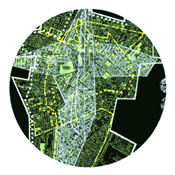introduction
THE VIRTUAL CITY

"Hell is a city much like London"
Shelley1
The city has been for a long time a literary and artistic subject: it is found time and again in many works of various nature and origin, as location of action and pretext for fiction, as well as, more significantly, the character and protagonist of the work as such. For the city - as it is a name for the human space par excellence, a space complex and ambiguous, and at the same time familiar and foreign, a place for daily exchanges and at the same time a discomforting and disconcerting labyrinth - was often used as a rhetorical device to represent creation as such, or even human condition in literature, poetry, visual art, cinema - and now, in Web art. Thus, the book, the dream, the memory, the brain, the world, utopia, paradise or hell all have been represented in turn by the metaphor, the metonymy, the allegory of the city.
But in addition, all cities are always already representations, images of themselves, of the country, the people, the cultures which inhabit them: the "invention" of the city was an act as much symbolic and utopian, as it was economic and political. All the cities have mythical bases, which become pretexts for tales, fantasy, anticipation. Thus all cities are so much more than a bunch of buildings, or a "simple" social and economic place of exchanges.
In this sense, all cities are virtual.
On the other hand, today, the metaphor of the city - and more specifically, that of the virtual city - finds itself widely used to designate the Web.
What is the virtual city?
French urbanist and theoretician Paul Virilio speaks of the "post-industrial metacity" heralding our entry into a new era of the city, in which the urban phenomenon spreads to the point of becoming one single planetary system, a city-world.
And sociologist Blaise Galland offers the following observations:
"When we experiment with information networks, we inevitably use the form of a city to represent this foreign world.
This ressemblance is felt by countless researchers, who see information technology not as developing into the "global village" that MacLuhan coined in the 60s - but rather as spawning something more akin to a "city" - an immense city. This "city" is taking form piece by piece."2
Thus the Web as virtual city is it in the process of becoming the city of all cities, the supra-city.
In this context, what relationships do the artists and the works on the Web maintain with the virtual city? How can Web art help us think and imagine the virtual city - and in it, through it, thanks to it, make all cities real or possible, visible or invisible, past or future - whether it be in an utopian or metaphorical, playful or critical manner?

Notes
1 : Percy Bysshe Shelley, Peter Bell the Third
(quoted by Stanza, The Central City) 
2 : Blaise Galland, Raisons et déraisons de la ville. Approche du champ urbain. Lausanne, PPUR 1996.
N.B. Read the interview with Blaise Galland in this magazine.
See also Judith Stefania Donath, Inhabiting the virtual city: The design of social environments for electronic communities, Massachusetts Institute of Technology, 1996.
(cf. especially, Part I: The virtual society - 2. The city and the body - 2.1 The metaphorical city)

Anne-Marie Boisvert,
Web Art Curator
Biennale de Montréal 2004

 top top
 back back
|
